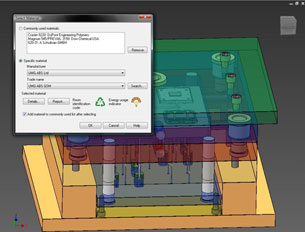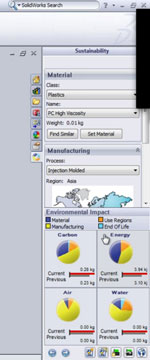Latest News
August 10, 2009
By Kenneth Wong
 Fig 1. The material selection dialog box in Autodesk Inventor Professional 2010’s Mold Layout tab features resin values and energy use indicator. |
Polyethylene is used to make, among other things, the disposable plastic bottles that hold our carbonated or mineral water. According to Container Recycling Institute, “Americans buy an estimated 34.6 billion single-serving (1 liter or less) plastic water bottles each year. Almost 8 out of 10 end up in a landfill or incinerator. Hundreds of millions end up as litter on roads and beaches or in streams and other waterways.”
Plastic’s durability, part of its appeal, might also be the reason for the difficulty to cope with its mass deployment. The tough, pliable material takes much longer to breakdown than, say, wood or paper. (Green advocacy groups like Green Upgrader and Clean Conscience cite that plastic bottles take roughly 700 years to compost, but the original study to back up this estimate is seldom referenced.)
In architecture software, the surge of interest in sustainable design has given birth to robust energy analysis packages (the most notable ones being Autodesk Ecotect and IES <VE>). Much of the effort is on predicting the ecological consequences of an architect’s material and system choices. For example, by calculating the volume of glazing or construction materials used, and by studying the selected cooling and heating mechanism (solar panels, natural gas, or others), the software calculates the building’s annual carbon emission and fuel consumption.
Such a movement is now under way in mechanical design software as well, though not as extensive as what’s seen in architecture. Two products that will encourage you to think long and hard about your material choices are Autodesk Inventor Professional 2010 and SolidWorks 2010.
Choose Wisely
At several press events in the past, Autodesk executives hinted that they were considering the inclusion of a carbon counter in Autodesk Inventor to help designers make more responsible choices. In Autodesk Inventor Professional 2010’s Mold Layout tools, you’ll find a material selection dialog box that lists resin identification code (developed by the Society of Plastics Industry to distinguish different types of plastics) and the energy use indicator (the expected energy required to produce the part using injection molding, calculated based on injection pressure, cooling time, geometry, and part thickness). It was a feature made possible by Autodesk’s acquisition of Moldflow in May 2008, which put Moldflow’s plastic testing labs and the associated databases in the AutoCAD giant’s pocket.
The resin codes, according to the American Chemistry Council, “are intended to help consumers know whether and how to recycle various plastic products and packages”—not necessarily an indicator of how easy or difficult it is to recycle these products.
Autodesk’s midrange CAD rival SolidWorks is also planning a similar feature. Dubbed SolidWorks SustainabilityXpress, the new module is now in beta, available for download and test-drive at SolidWorks Labs. SolidWorks’ material knowledge comes from its partnership with PE-International, a firm that describes its specialty as “Life Cycle Assessment and Sustainability.”
 Fig 2. SolidWorks SustainabilityXpress, now in beta, will give SolidWorks 2010 users the ability to foresee the consequences of their material procurement and manufacturing method choices. |
SustainabilityXpress calculates the environmental impact of your design in four areas—carbon output, fuel consumption, air pollution, and water pollution—based on your material choice, manufacturing method, manufacturing location, and targeted sales region. SustainabilityXpress is expected to become part of SolidWorks 2010.
For more on Autodesk Inventor Professional 2010, read “Bridging MCAD Quadrants with 2010,” April 8, 2009. For more on SolidWorks SustainabilityXpress, read “Sage Advice on Sustainability,” July 1, 2009.
Creative Solutions for Plastic
In May 2009, David de Rothschild, an English adventurer and environmentalist, took the stage at Greener by Design, a conference organized by Greener World Media Inc. Rothschild was constructing a 60-ft. catamaran out of discarded plastic bottles. Once the boat is completed, he plans to sail from San Francisco to Sydney. He hopes his Plastiki Expedition would inspire people to reduce waste, seek sustainable solutions, and take note of the ecological damage to the world’s oceans. (While he spoke, attendees holding plastic water bottles squirmed.)
In Waterloo, Ontario, a high school junior by the name of Daniel Burd may have found a way to make plastic compost fast—definitely faster than it would take if the process were left to nature. Wired magazine reported, “Burd mixed landfill dirt with yeast and tap water, then added ground plastic and let it stew. The plastic indeed decomposed more quickly than it would in nature; after experimenting with different temperatures and configurations, Burd isolated the microbial munchers. One came from the bacterial genus Pseudomonas, and the other from the genus Sphingomonas.” Burd believes his experiment could be repeated on a larger scale with minimal impact on the environment.
If you know of other design projects that might make the world a better place, please alert us. Better yet, if you happen to be involved in one, please submit your work to us. We’re on the lookout for candidates to Desktop Engineering’s Designs that Will Change the World Challenge.
Subscribe to our FREE magazine, FREE email newsletters or both!
Latest News
About the Author
Kenneth Wong is Digital Engineering’s resident blogger and senior editor. Email him at [email protected] or share your thoughts on this article at digitaleng.news/facebook.
Follow DE





